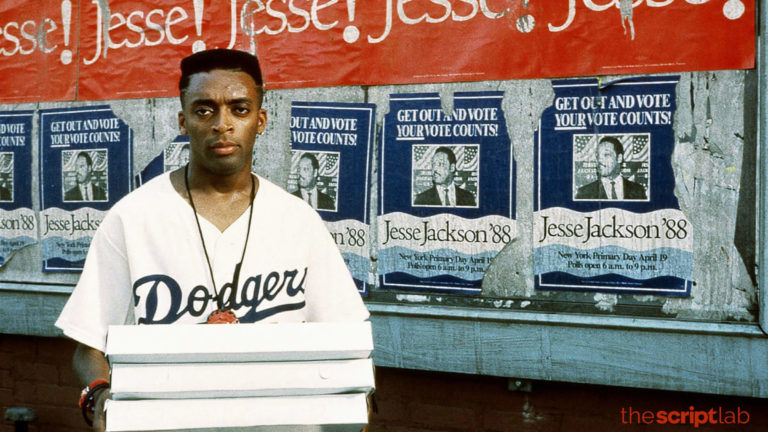By David Young · January 12, 2022

From comedy to drama, tragedy to satire, Spike Lee is a versatile, talented filmmaker with a wide set of tools he uses to tell his stories.
You’ll notice his films are always introduced the same way: “A Spike Lee Joint”. You’ll notice the use of archival footage to get across a particular message, be it written in (like the Malcolm X footage at the end of Bamboozled) or a directorial decision, like the footage from Charlottesville’s Unite the Right rally at the end of BlacKkKlansman — a decision that was meant to highlight the prevalence of the white nationalist agenda in present times.
But similarities in Lee’s stories don’t just end with what’s on-screen. His writing has a style and voice that’s all his own, and below are just some examples of the specific traits that stand out as a part of his creations on paper.
One of the things any Spike Lee fan can tell you for a fact is that there’s always a plot to his stories. I don’t mean a plot like a narrative — that part is a given. What I mean is that there’s always a big plan, a plan from a character that generally has a note of outlandishness to it: from the real story of an undercover cop of color in the KKK (BlacKkKlansman) to a Black writer dooming himself into producing a modern minstrel show (Bamboozled).
There’s an element of the incredible to each of his stories. More than that, the endings contribute to this larger-than-life feeling, as many of Lee’s stories end violently to a point, such as with the destruction of a pizza joint over a small disagreement that escalates wildly over the course of the day (Do The Right Thing). That, like the bloody mess that concludes Bamboozled, showcases the dramatic “bigness” of his narratives.

‘Do the Right Thing’
The power of language can’t be overstressed, and that’s all the more true in a Spike Lee script. Written dialects demonstrate the stark differences between populations in Do The Right Thing, as we see between Italian New Yorkers like Sal, Black New Yorkers like Mister Señor Love Daddy, and even the stilted language separates (and saves the life of) a Korean shop owner from the rest.
In Bamboozled, the steady use of specific language even goes to show how ignorant many of the station people are about people of color, and in BlacKkKlansman, the same goes for David Duke’s poorly informed impressions of African American Vernacular English (AAVE). Lee isn’t limited to using only these devices in dialogue, either: Even specific sayings, like “starvin’ like Marvin,” find their way into multiple of the stories he writes.
Here’s another interesting feature of Spike Lee stories: there’s always an intro from a voice external to the story, written or spoken, and always to set the tone or world for the story.
You see this in the footage of Beauregard and his white nationalist propaganda film (BlacKkKlansman), a quoted excerpt from Malcolm X’s autobiography (Do The Right Thing), or Malcolm X’s voice ringing out above the masses before Delacroix speaks to the audience head-on (Bamboozled).

‘BlacKkKlansman’
It’s important to note that Lee’s scripts deal with the hard truths of the Black experience, and that’s captured in every story to some degree. Be it the stories of the Black men fighting for their country in Vietnam (Da 5 Bloods) or the experiences of Black professionals in an overly white-leaning industry (Bamboozled), these narratives are equipped to showcase racial interaction and reaction.
Some prominent examples include the various montaged slur exchanges between feuding populations in Brooklyn in Do The Right Thing — all used to show how volatile these interactions can become when misguided. Lee’s written and directorial voices always have awareness of this danger at the forefront: he acknowledges in his stories the way that communication can break down because of racial bias or hate.
Spike Lee is also very much an artist, an auteur, with his films, and that bleeds through in his writing for certain. Through various devices, he demonstrates this, but one way, in particular, is through his intimately descriptive, conversational writing, especially when introducing characters.
Consider the following of Eddie in Da 5 Bloods:
“He’s dressed in affluent Southwest style, owner of a string of Car Dealerships, who has gone through numerous Wives and Gallons of Courvoisier.”

‘Da 5 Bloods’
The information Lee offers us helps paint a picture of the character, and he does this the same way when he describes the initiator of the violence in Do The Right Thing, Radio Raheem.
He describes Radio Raheem’s radio, his most unique trait — heavy and huge — but he also tells us something about Raheem personality through one detail: “The song we hear is the only one Radio Raheem plays.”

Radio Raheem in ‘Do the Right Thing’
Lee’s goal in these types of descriptions is to prepare us for some inside perspective of a character’s personality, and whether it’s through a slice of backstory or a habit of theirs, he succeeds visually.
While Spike Lee has other trademarks in his stories, these are some of those that appear very regularly. They’re part of what makes his scripts so powerful. He also makes nods to his other scripts, like with “that’s the truth, Ruth!” (a line from Mister Señor Love Daddy that makes its way onto the screenplay for BlacKkKlansman). His tongue-in-cheek references on the title page alone make it clear who you’re about to read. When it comes down to it, though, every single one is still a fresh experience and a gold mine for powerful interpersonal motivations, dramatic wit, and dark humor, so it’s best if you read them yourself!
—
 David Wayne Young is an independent film producer and screenwriter with years of experience in story analysis, even providing coverage for multiple international screenwriting competitions. David’s obsessions include weird fiction and cosmic horror, and he’s formally trained in the art of tasting and preparing gourmet coffee in various worldly traditions, from Turkish coffee to hand-tamped espresso — all enjoyed while writing, of course.
David Wayne Young is an independent film producer and screenwriter with years of experience in story analysis, even providing coverage for multiple international screenwriting competitions. David’s obsessions include weird fiction and cosmic horror, and he’s formally trained in the art of tasting and preparing gourmet coffee in various worldly traditions, from Turkish coffee to hand-tamped espresso — all enjoyed while writing, of course.